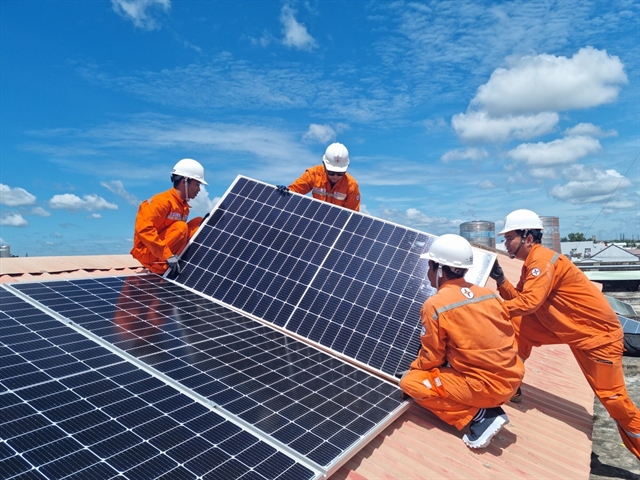 |
| Installation of solar panels on a factory’s rooftop in HCM City. — VNA/VNS Photo |
HÀ NỘI — Without a long-term strategy and faster localisation, Việt Nam’s energy sector could very well fall short in the competition for renewable energy market share on home ground, said industry insiders and experts.
In a recent study by UK-based think tank Ember, Việt Nam accounted for 69 per cent of all solar and wind power output in ASEAN in 2022, which was estimated at 50TWh.
Vũ Chi Mai, director of Clean, Affordable and Secure Energy for Southeast Asia (CASE), a programme that drives change in the Southeast Asian power sector towards an increased ambition concerning climate change mitigation, said the Southeast Asian country’s stable socio-political environment makes it among some of the most attractive investment destinations for solar and wind power business in the region.
In addition, the Vietnamese government has implemented numerous preferential policies, aimed at supporting renewable energy, paving the way for the development of a substantial market and workforce.
Mai said the country has the potential to promote domestic market localisation, with the proportion increasing from 45 per cent to nearly 80 per cent for solar power and from 37 per cent to 55 per cent for wind power by 2050. The value of localisation could reach US$80 billion, or 50 per cent of the total market potential.
However, participation by Vietnamese businesses in the industry has been somewhat lacklustre. Consequently, the market share, valued at billions of dollars, remains predominantly in the hands of foreign enterprises.
According to experts from CASE, the current supply capabilities of domestic enterprises in the renewable energy sector are limited, with the onshore wind sector in Việt Nam lacking the production of nacelles (wind turbine housing), hubs, rotor blades, and underwater cables have not been produced. Statistics show that 90% of equipment for renewable energy projects is still imported.
Contributing factors included a lack of assessment capacity, and infrastructure, in addition to insufficient technological capabilities and production levels that do not meet the requirements. Moreover, the industrial support policies for renewable energy are still inadequate.
Industry insiders and experts have long called for a faster rate of localisation and less dependence on foreign companies.
A case study that may be useful for Việt Nam is China. When European wind turbine manufacturers went to China, the country also required them to meet a certain level of localisation and transfer specific technologies.
As a result, China’s renewable developed rapidly and rose to become the global leader in the solar energy sector. Currently, China’s GoldWind, a wind power generation company, holds the second-largest share of the global market. In a very short period, China achieved this because of its favourable policies encouraging localisation. This serves as a lesson for Vietnam to “follow, but lead” by setting conditions for renewable energy technology leaders to hold the leading technology, Mai said.
In addition, to absorb technology from FDI regions, businesses need to continue evaluating the capabilities of companies in the wind and solar value chain, including support industry enterprises. Simultaneously, boosting research and development, technology transfer, experimental projects, and developing skilled manpower is essential for maximum localisation.
Đinh Văn Tuấn, Deputy General Director of Ba Son Corporation, one of the first domestic companies to participate in manufacturing wind turbine towers, believes that Vietnamese businesses are taking advantage of opportunities to produce final products for foreign renewable energy partners. However, the biggest obstacle for enterprises is the policy mechanism and pricing. Without mastering technology, the cost of production will be high, leading to low competitiveness.
“Viet Nam is following, so it needs support from the government in terms of mechanisms and policies to transfer technology, and invest in new, modern production lines. Only in this way can we reduce production cost, increase competitiveness for domestic businesses, and integrate deeper into the global value chain,” he said. —VNS
- Reduce Hair Loss with PURA D’OR Gold Label Shampoo
- Castor Oil Has Made a “Huge” Difference With Hair and Brow Growth
- Excessive hair loss in men: Signs of illness that cannot be subjective
- Dịch Vụ SEO Website ở Los Angeles, CA: đưa trang web doanh nghiệp bạn lên top Google
- Nails Salon Sierra Madre
 VnExpress News The News Gateway of Vietnam
VnExpress News The News Gateway of Vietnam




